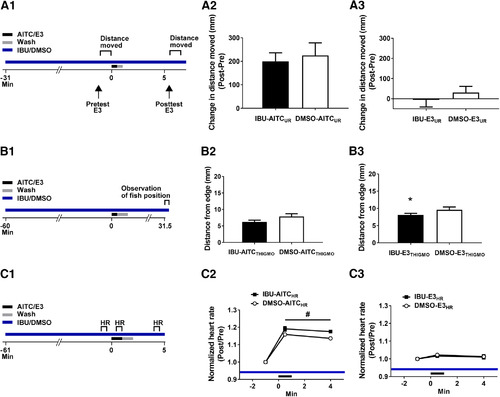
IBU does not block the enhancement of locomotion, thigmotaxis, and heart rate caused by AITC in larval zebrafish. A1, Experimental protocol to test the effects of IBU on locomotion in freely moving larvae. A2, The groups exposed to AITC (10 μm, 30-s duration; IBU-AITCUR group, n = 10; DMSO-AITCUR group, n = 10) did not differ significantly in the distance moved, regardless of whether or not IBU was present in the bath, as indicated by an unpaired t test (t(18) = 0.39; p = 0.70). A3, The presence of IBU did not change the distance of movement in the groups (IBU-E3UR group, n = 10; DMSO-E3UR group, n = 10) that were treated with E3 for 30 s rather than the irritant. The difference between the two groups was nonsignificant (unpaired t test: t(18) = 0.79, p = 0.44). B1, Experimental protocol used to test the effects of IBU on thigmotaxis. B2, Effect of IBU/DMSO on thigmotaxis at 31.5 min after the onset of treatment with AITC/E3 (30-s duration). Thigmotaxis in fish placed into IBU and AITC (IBU-AITCTHIGMO group, n = 18) was indistinguishable from that of fish placed in DMSO and AITC (DMSO-AITCTHIGMO group, n = 20; t(36) = 1.04, p = 0.31). B3, Effect of IBU/DMSO on thigmotaxis at 30 min after treatment with E3. Fish placed in IBU and then exposed for 30 s to (fresh) E3 (IBU-E3THIGMO, n = 20) exhibited greater thigmotaxis than did fish treated identically except for being placed in DMSO before E3 exposure (DMSO-E3THIGMO group, n = 20; t(38) = 2.42, p = 0.02). C1, Experimental protocol used to examine the effect of IBU on the increase in larval heart rate caused by AITC. C2, Effect of IBU/DMSO on the AITC-induced alteration in heart rate. A repeated-measures, two-way ANOVA revealed a significant overall effect of drug exposure (F(1,10) = 6.89, p = 0.03). The fish placed in IBU before AITC exposure (IBU-AITCHR group, n = 6) exhibited a faster normalized heart rate while the chemical irritant was present in the bath, as well as at 2 min after washout of AITC, than did fish placed in DMSO before being treated with AITC (DMSO-AITCHR group, n = 6). C3, Effect of IBU/DMSO on baseline larval heart rate. A repeated-measures, two-way ANOVA revealed no significant effect of drug exposure (F(1,8) = 0.19, p = 0.67). Neither the fish initially immersed in IBU-containing solution (IBU-E3HR group, n = 5) nor the fish initially immersed in the vehicle (DMSO-E3HR group, n = 5) showed any alterations in normalized heart in response to treatment with E3. This figure shows means ± SEM, with * indicating a significant (p < 0.05) difference between groups and # indicating a significant (p < 0.05) main effect.
|

